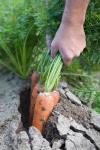“Extension on the Go” podcast by Debbie Johnson. Episode 156: The Year of the Carrot
COLUMBIA, Mo. – Bugs Bunny was always seen nonchalantly munching on a carrot. Considering that the carrot is tasty and nutritious, that makes Bugs one smart bunny.
This is the year to celebrate the crunchy, tasty carrot. The National Garden Bureau has named the carrot the edible crop for 2016.
“It’s a vegetable that’s extremely nutritious, providing beta carotene, dietary fiber and minerals,” said David Trinklein, horticulture specialist for University of Missouri Extension. “It has also been the recipient of a lot of improvement over the ages.”
History
Carrots didn’t start out as a great addition to salads and soups. You would have needed the proverbial spoonful of sugar to help early carrots to go down.
“It might have been more than you could choke down,” Trinklein said. “Early carrots were purple to deep orange, very small, pungent and bitter-tasting.”
Initially, carrots were used for medicinal purposes. Then plant breeders began to make changes. Trinklein says the orange carrot was developed in 16th century Holland as a tribute to King William I, Prince of Orange.
“A couple of centuries ago the carrot was improved to become the crop we know today, and it’s one of the top 10 vegetables,” Trinklein said.
Varieties
Carrots are divided into a number of different types based on their root shape, Trinklein said. Chantenay carrots are short, triangular and very sweet. He says not many of this type are grown, even in home gardens.
Most home garden carrots are of the Danvers type, he said. These have triangular tops, are somewhat elongated and very sweet. They’re usually dark orange in color, although there are some purple varieties.
“The carrots that you purchase at the supermarket belong to the Imperator type,” Trinklein said. “They’re cylindrical and not triangular-shaped and usually much longer.”
Growing and harvesting
While carrots are easy to grow, they do require loose soil that drains well.
“Soil structure is very important for a root crop because it has to be able to physically push the large root through the soil,” Trinklein said. “Also, roots need oxygen, which is higher in concentration in loose soils than compact soils.”
Carrots can be planted early because, as cool-season vegetables, they can withstand some frost. You can plant the seeds two to three weeks before the last spring frost date, provided the soil has warmed a bit, Trinklein said.
One thing to keep in mind is that carrots are a little difficult to germinate, especially in heavy soils. Trinklein recommends incorporating organic matter to loosen the soil. Purchasing a soilless medium to dust over the tops of the seeds will keep them moist without crusting over. Tiny carrot seedlings have difficulty breaking through crusted clay soil.
Direct-seed carrots into the garden with 12-18 inches between the rows. Sow carrot seeds densely within the rows. This will pay off because you can eat the young carrots as you thin them out, Trinklein said. The first tiny roots can go into salads. Then, as they get bigger, you’ll have true baby carrots to add to your table. Once the carrots are thinned out to 3-4 inches between plants, you can let them grow to mature-size carrots.
As the carrots grow, you can harvest them as you need them. However, the eating quality of carrots declines as temperatures rise. Trinklein said that by mid-to-late July the sweetness will be reduced and the root will become more fibrous.
SIDEBAR
Carrot recipes
ROASTED CARROTS
12 carrots, cut into 1 1/2-inch slices
2 tablespoons olive oil
1 teaspoon salt
1/2 teaspoon pepper
2 tablespoons parsley, minced
Heat oven to 400 F. Mix together olive oil, salt, pepper and parsley. Toss with carrot slices. Place in a single layer on a baking sheet. Roast for 20 minutes or until brown and tender.
(Recipe from “Seasonal and Simple: A Guide for Enjoying Fresh Fruits and Vegetables,” http://extension.missouri.edu/p/MP909.)
CARROT CUPCAKES
Yield: 1 dozen cupcakes
Ingredients
Cupcakes:
2/3 cup granulated sugar
3 tablespoons vegetable oil
1 teaspoon vanilla extract
1 large egg
1 cup finely shredded carrot
1 (8-ounce) can crushed pineapple in juice, well-drained
1 cup all-purpose flour
1 teaspoon baking powder
3/4 teaspoon ground cinnamon
1/4 teaspoon baking soda
1/8 teaspoon salt
1/8 teaspoon ground nutmeg
1/4 cup raisins
Frosting:
1/4 cup (2 ounces) 1/3-less-fat cream cheese, chilled
1/8 teaspoon imitation coconut flavor (optional)
1 1/3 cups powdered sugar
3 tablespoons flaked sweetened coconut
Preparation
Heat oven to 350 F.
To prepare cupcakes, beat first 4 ingredients in a mixer at medium speed until well-blended. Add carrot and pineapple; beat well.
Lightly spoon flour into a dry measuring cup; level with a knife. Combine flour and next 5 ingredients (flour through nutmeg) in a bowl, stirring well with a whisk. Add flour mixture to sugar mixture (from step 2); beat well. Stir in raisins.
Spoon batter into 12 muffin cups lined with paper liners. Bake at 350 for 20 minutes or until a wooden pick inserted in center comes out clean. Cool in pan 5 minutes on a wire rack; remove from pan. Cool completely on wire rack.
To prepare frosting, beat the cream cheese and coconut flavor in a mixer at medium speed just until blended. Gradually add powdered sugar (do not overbeat). Spread frosting over cupcakes; sprinkle with flaked coconut. Store, covered, in refrigerator.
Nutrition information per serving (serving size: 1 cupcake)
Calories: 220 (27% from fat)
Fat: 6.6 g (sat 2.5 g, mono 1.8 g, poly 1.9 g)
Protein: 2.4 g
Carbohydrate: 38.7 g
Fiber: 0.9 g
Cholesterol: 25 mg
Iron: 0.8 mg
Sodium: 133 mg
Calcium: 38 mg
(Recipe from MissouriFamilies.org.)
Read more http://extension.missouri.edu/news/DisplayStory.aspx?N=2705





